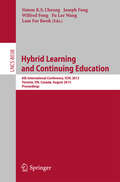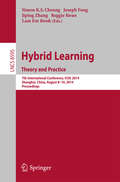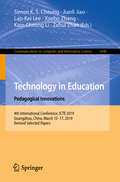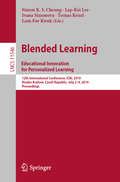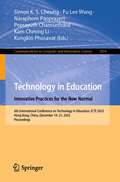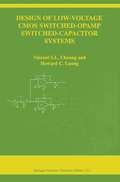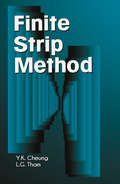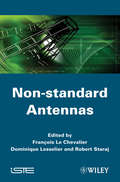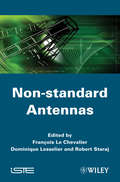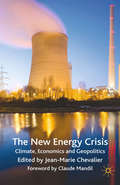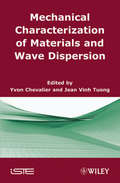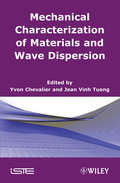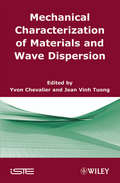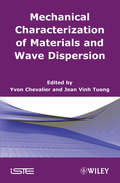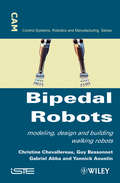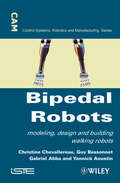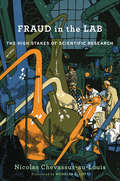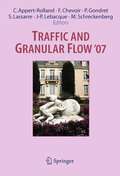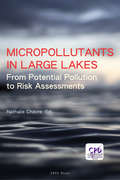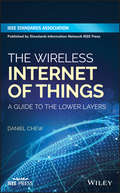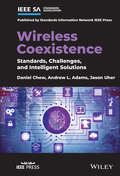- Table View
- List View
Hybrid Learning and Continuing Education: 6th International conference, ICHL 2013, Toronto, ON, Canada, August 12-14, 2013, Proceedings (Lecture Notes in Computer Science #8038)
by Simon K. S. Cheung Joseph Fong Wilfred Fong Fu Lee Wang Lam For KwokThis book constitutes the refereed proceedings of the 6th International Conference on Hybrid Learning, ICHL 2013, held in Toronto, ON, Canada, in August 2013. The 35 papers presented in this volume were carefully reviewed and selected from numerous submissions. The selected articles broadly cover topics on hybrid learning and continuing education, including computer supported collaborative learning, experiences in hybrid learning, pedagogical and psychological issues, e-learning and mobile learning, open education resources and open online courses, and issues in hybrid learning and continuing education.
Hybrid Learning Theory and Practice: 7th International Conference, ICHL 2014, Shanghai, China, August 8-10, 2014. Proceedings (Lecture Notes in Computer Science #8595)
by Simon K. S. Cheung Joseph Fong Jiping Zhang Reggie Kwan Lam For KwokThis book constitutes the refereed proceedings of the 7th International Conference on Hybrid Learning, ICHL 2014, held in Shanghai, China, in August 2014. The 31 papers presented were carefully reviewed and selected from 90 submissions. The selected papers cover various aspects on hybrid learning, computer supported collaborative learning, expericiences in hybrid learning, improved flexibility on learning processes and the pedagogical and psychological issues of hybrid learning.
Technology in Education: 4th International Conference, ICTE 2019, Guangzhou, China, March 15-17, 2019, Revised Selected Papers (Communications in Computer and Information Science #1048)
by Simon K. S. Cheung Jianli Jiao Lap-Kei Lee Xuebo Zhang Kam Cheong Li Zehui ZhanThis book constitutes extended papers from the 4th International Conference on Technology in Education, ICTE 2019, held in Guangzhou, China, in March 2019.The 27 full papers presented in this volume were carefully reviewed and selected from 109 submissions. They are organized in topical sections on blended bearning and computer-supported learning; virtual reality, augmented reality and game-based learning; open online courses and open educational resources; teaching and learning analysis and assessment; pedagogical, psychological and cultural issues.
Blended Learning: 12th International Conference, ICBL 2019, Hradec Kralove, Czech Republic, July 2–4, 2019, Proceedings (Lecture Notes in Computer Science #11546)
by Simon K. S. Cheung Lap-Kei Lee Ivana Simonova Tomas Kozel Lam-For KwokThis book constitutes the refereed proceedings of the 12th International Conference on Blended Learning, ICBL 2019, held in Hradec Kralove, Czech Republic, in July 2019. The 28 papers presented were carefully reviewed and selected from 80 submissions. The papers are organized in topical sections named: personalized and adaptive learning; content development for blended learning; experience in blended learning; analytics and evaluation for blended learning; open educational resources; and pedagogical and psychological issues.
Technology in Education. Innovative Practices for the New Normal: 6th International Conference on Technology in Education, ICTE 2023, Hong Kong, China, December 19–21, 2023, Proceedings (Communications in Computer and Information Science #1974)
by Simon K. S. Cheung Fu Lee Wang Naraphorn Paoprasert Peerayuth Charnsethikul Kam Cheong Li Kongkiti PhusavatThis book constitutes the refereed proceedings of the 6th International Conference on Technology in Education. Innovations for Online Teaching and Learning, ICTE 2023, held in Hong Kong, China, during December 19–21, 2023.The 30 full papers included in this book were carefully reviewed and selected from 74 submissions. They were organized in topical sections as follows: keynote papers; online and innovative learning; personalized and individualized learning; smart learning environment; artificial intelligence in education; and institutional strategies and practices.
Design of Low-Voltage CMOS Switched-Opamp Switched-Capacitor Systems (The Springer International Series in Engineering and Computer Science #737)
by Vincent S.L. Cheung Howard Cam LuongThis volume emphasizes the design and development of advanced switched-opamp architectures and techniques for low-voltage low-power switched-capacitor systems. It presents a novel multi-phase switched-opamp technique together with new system architectures that are critical in improving significantly the performance of switched-capacitor systems at low supply voltages.
The Finite Strip Method (New Directions In Civil Engineering Ser. #17)
by Y. K. Cheung L. G. ThamThe increase in the popularity and the number of potential applications of the finite strip method has created a demand for a definitive text/reference on the subject. Fulfilling this demand, The Finite Strip Method provides practicing engineers, researchers, and students with a comprehensive introduction and theoretical development, and a complete treatment of current practical applications of the method.Written by experts who are arguably the world's leading authorities in the field, The Finite Strip Method covers both the classical strip and the newly developed spline strip and computed shape function strip. Applications in structural engineering, with particular focus on practical structures such as slab-beam bridges, box girder bridges, and tall buildings are discussed extensively. Applications in geotechnology are also covered, as are recently formulated applications in nonlinear analysis.The Finite Strip Method is a unique book, supplying much-needed information by well-known and highly regarded authors.
The Finite Strip Method
by Y. K. Cheung L. G. ThamThe increase in the popularity and the number of potential applications of the finite strip method has created a demand for a definitive text/reference on the subject. Fulfilling this demand, The Finite Strip Method provides practicing engineers, researchers, and students with a comprehensive introduction and theoretical development, and a complete treatment of current practical applications of the method.Written by experts who are arguably the world's leading authorities in the field, The Finite Strip Method covers both the classical strip and the newly developed spline strip and computed shape function strip. Applications in structural engineering, with particular focus on practical structures such as slab-beam bridges, box girder bridges, and tall buildings are discussed extensively. Applications in geotechnology are also covered, as are recently formulated applications in nonlinear analysis.The Finite Strip Method is a unique book, supplying much-needed information by well-known and highly regarded authors.
Non-standard Antennas
by François Le Chevalier Dominique Lesselier Robert StarajThis book aims at describing the wide variety of new technologies and concepts of non-standard antenna systems – reconfigurable, integrated, terahertz, deformable, ultra-wideband, using metamaterials, or MEMS, etc, and how they open the way to a wide range of applications, from personal security and communications to multifunction radars and towed sonars, or satellite navigation systems, with space-time diversity on transmit and receive. A reference book for designers in this lively scientific community linking antenna experts and signal processing engineers.
Non-standard Antennas
by François Le Chevalier Dominique Lesselier Robert StarajThis book aims at describing the wide variety of new technologies and concepts of non-standard antenna systems – reconfigurable, integrated, terahertz, deformable, ultra-wideband, using metamaterials, or MEMS, etc, and how they open the way to a wide range of applications, from personal security and communications to multifunction radars and towed sonars, or satellite navigation systems, with space-time diversity on transmit and receive. A reference book for designers in this lively scientific community linking antenna experts and signal processing engineers.
The New Energy Crisis: Climate, Economics and Geopolitics
by J. ChevalierThe New Energy Crisis comes from the recent intrusion of climate change issues into energy economics and geopolitics. Global warming reveals that the current evolution of the world energy consumption is on an unsustainable path. This book explores economic and geopolitical tensions and reinforces ways to overcome the crisis.
Mechanical Characterization of Materials and Wave Dispersion: Instrumentation and Experiment Interpretation
by Yvon Chevalier Jean Vinh TuongOver the last 50 years, the methods of investigating dynamic properties have resulted in significant advances. This book explores dynamic testing, the methods used, and the experiments performed, placing a particular emphasis on the context of bounded medium elastodynamics. Dynamic tests have proven to be as efficient as static tests and are often easier to use at lower frequency. The discussion is divided into four parts. Part A focuses on the complements of continuum mechanics. Part B concerns the various types of rod vibrations: extensional, bending, and torsional. Part C is devoted to mechanical and electronic instrumentation, and guidelines for which experimental set-up should be used are given. Part D concentrates on experiments and experimental interpretations of elastic or viscolelastic moduli. In addition, several chapters contain practical examples alongside theoretical discussion to facilitate the readers understanding. The results presented are the culmination of over 30 years of research by the authors and as such will be of great interest to anyone involved in this field.
Mechanical Characterization of Materials and Wave Dispersion
by Yvon Chevalier Jean Vinh TuongDynamic tests have proven to be as efficient as static tests and are often easier to use at lower frequency. Over the last 50 years, the methods of investigating dynamic properties have resulted in significant advances. This book explores dynamic testing, the methods used, and the experiments performed, placing a particular emphasis on the context of bounded medium elastodynamics. The discussion is divided into four parts. Part A focuses on the complements of continuum mechanics. Part B concerns the various types of rod vibrations: extensional, bending, and torsional. Part C is devoted to mechanical and electronic instrumentation, and guidelines for which experimental set-up should be used are given. Part D concentrates on experiments and experimental interpretations of elastic or viscolelastic moduli. In addition, several chapters contain practical examples alongside theoretical discussion to facilitate the reader?s understanding. The results presented are the culmination of over 30 years of research by the authors and as such will be of great interest to anyone involved in this field.
Mechanical Characterization of Materials and Wave Dispersion: Instrumentation and Experiment Interpretation
by Yvon Chevalier Jean Tuong VinhOver the last 50 years, the methods of investigating dynamic properties have resulted in significant advances. This book explores dynamic testing, the methods used, and the experiments performed, placing a particular emphasis on the context of bounded medium elastodynamics. Dynamic tests have proven to be as efficient as static tests and are often easier to use at lower frequency. The discussion is divided into four parts. Part A focuses on the complements of continuum mechanics. Part B concerns the various types of rod vibrations: extensional, bending, and torsional. Part C is devoted to mechanical and electronic instrumentation, and guidelines for which experimental set-up should be used are given. Part D concentrates on experiments and experimental interpretations of elastic or viscolelastic moduli. In addition, several chapters contain practical examples alongside theoretical discussion to facilitate the readers understanding. The results presented are the culmination of over 30 years of research by the authors and as such will be of great interest to anyone involved in this field.
Mechanical Characterization of Materials and Wave Dispersion
by Yvon Chevalier Jean Tuong VinhDynamic tests have proven to be as efficient as static tests and are often easier to use at lower frequency. Over the last 50 years, the methods of investigating dynamic properties have resulted in significant advances. This book explores dynamic testing, the methods used, and the experiments performed, placing a particular emphasis on the context of bounded medium elastodynamics. The discussion is divided into four parts. Part A focuses on the complements of continuum mechanics. Part B concerns the various types of rod vibrations: extensional, bending, and torsional. Part C is devoted to mechanical and electronic instrumentation, and guidelines for which experimental set-up should be used are given. Part D concentrates on experiments and experimental interpretations of elastic or viscolelastic moduli. In addition, several chapters contain practical examples alongside theoretical discussion to facilitate the reader?s understanding. The results presented are the culmination of over 30 years of research by the authors and as such will be of great interest to anyone involved in this field.
Bipedal Robots: Modeling, Design and Walking Synthesis
by Christine Chevallereau Gabriel Abba Yannick Aoustin Guy BessonnetThis book presents various techniques to carry out the gait modeling, the gait patterns synthesis, and the control of biped robots. Some general information on the human walking, a presentation of the current experimental biped robots, and the application of walking bipeds are given. The modeling is based on the decomposition on a walking step into different sub-phases depending on the way each foot stands into contact on the ground. The robot design is dealt with according to the mass repartition and the choice of the actuators. Different ways to generate walking patterns are considered, such as passive walking and gait synthesis performed using optimization technique. Control based on the robot modeling, neural network methods, or intuitive approaches are presented. The unilaterality of contact is dealt with using on-line adaptation of the desired motion.
Bipedal Robots: Modeling, Design and Walking Synthesis (Iste Ser. #28)
by Christine Chevallereau Guy Bessonnet Gabriel Abba Yannick AoustinThis book presents various techniques to carry out the gait modeling, the gait patterns synthesis, and the control of biped robots. Some general information on the human walking, a presentation of the current experimental biped robots, and the application of walking bipeds are given. The modeling is based on the decomposition on a walking step into different sub-phases depending on the way each foot stands into contact on the ground. The robot design is dealt with according to the mass repartition and the choice of the actuators. Different ways to generate walking patterns are considered, such as passive walking and gait synthesis performed using optimization technique. Control based on the robot modeling, neural network methods, or intuitive approaches are presented. The unilaterality of contact is dealt with using on-line adaptation of the desired motion.
Fraud in the Lab: The High Stakes of Scientific Research
by Nicolas Chevassus-au-LouisFrom manipulated results and fake data to retouched illustrations and plagiarism, cases of scientific fraud have skyrocketed in the past two decades. In a damning exposé, Nicolas Chevassus-au-Louis details the circumstances enabling the decline in scientific standards and highlights efforts to curtail future misconduct.
Traffic and Granular Flow ' 07
by François Chevoir Philippe Gondret Sylvain Lassarre Jean-Patrick Lebacque Michael Schreckenberg Cécile Appert-RollandMicropollutants in Large Lakes: From Potential Pollution Sources to Risk Assessments
by Nathalie ChevreScientists, regulators, and the general public are now more and more aware of the chemicals present in surface waters worldwide. Agrochemicals, such as herbicides or insecticides, pharmaceuticals and cosmetics can be detected at low to medium concentrations in seas, groundwaters and rivers. Among freshwaters, lakes are of particular concern. These large reservoirs are used as sources of food and drinking water, but also serve for recreational activities. This book aims in presenting insights into the physical, chemical, and ecological dynamics of large lakes that enable proposing recommendations for sustainable lake management regarding chemicals. Lake Geneva, Switzerland, is used as a case study, but the developed methodologies and tools can be useful for lake water quality management in general. A first chapter is dedicated to the chemicals entering the lake through agriculture. These are mainly pesticides. After a review of the different types of compounds, the authors present the main pathways these compounds follow to enter the lake. The case of glyphosate, an herbicide largely used worldwide, is presented. A second chapter illustrates the urban source of pollutants with the case of pharmaceuticals and biocides. Two models are presented that allow estimating the load and the dynamic of these chemicals that may exit from an urban catchment and therefore reach a lake. Special attention will be paid to the ‘end of pipe’ removal of these compounds at a WWTP. A third chapter is dedicated to the lake circulation. The aim of this chapter is to present an overall description of the lake’s hydrodynamics, which is driven by three factors: wind, temperature and Coriolis forces. To achieve this aim, a hydrodynamic model is presented that allows describing the behavior of the top layer of the lake based on the wind direction. The importance of stable hydrogen and oxygen isotopes for characterizing the sources of water and the mixing processes in the lake is also described. The next chapters are dedicated to a Bay, called the Vidy Bay, that receives the treated effluents of the largest wastewater treatment plant of the lake catchment. This latter represents therefore one of the major point sources of contaminants for lake Geneva. These two chapters will focus on the various processes that control the transfer of chemicals (associated to particles or in a dissolved state) discharged into the bay and transported to the lake’s main water body. Then, a next chapter focuses on one major issue of chemicals in aquatic systems like lakes, i.e. the risk of the mixture of chemicals. The evaluation of the risk of mixture is not trivial and the models that allow doing it are presented in a critical way. Their validity as predictive tools is illustrated with the example of herbicides mixture in Lake Geneva. A final chapter synthesizes the main findings and discusses some recommendations for the management of large lakes regarding micropollution.
Micropollutants in Large Lakes: From Potential Pollution Sources to Risk Assessments
by Nathalie ChevreScientists, regulators, and the general public are now more and more aware of the chemicals present in surface waters worldwide. Agrochemicals, such as herbicides or insecticides, pharmaceuticals and cosmetics can be detected at low to medium concentrations in seas, groundwaters and rivers. Among freshwaters, lakes are of particular concern. These large reservoirs are used as sources of food and drinking water, but also serve for recreational activities. This book aims in presenting insights into the physical, chemical, and ecological dynamics of large lakes that enable proposing recommendations for sustainable lake management regarding chemicals. Lake Geneva, Switzerland, is used as a case study, but the developed methodologies and tools can be useful for lake water quality management in general. A first chapter is dedicated to the chemicals entering the lake through agriculture. These are mainly pesticides. After a review of the different types of compounds, the authors present the main pathways these compounds follow to enter the lake. The case of glyphosate, an herbicide largely used worldwide, is presented. A second chapter illustrates the urban source of pollutants with the case of pharmaceuticals and biocides. Two models are presented that allow estimating the load and the dynamic of these chemicals that may exit from an urban catchment and therefore reach a lake. Special attention will be paid to the ‘end of pipe’ removal of these compounds at a WWTP. A third chapter is dedicated to the lake circulation. The aim of this chapter is to present an overall description of the lake’s hydrodynamics, which is driven by three factors: wind, temperature and Coriolis forces. To achieve this aim, a hydrodynamic model is presented that allows describing the behavior of the top layer of the lake based on the wind direction. The importance of stable hydrogen and oxygen isotopes for characterizing the sources of water and the mixing processes in the lake is also described. The next chapters are dedicated to a Bay, called the Vidy Bay, that receives the treated effluents of the largest wastewater treatment plant of the lake catchment. This latter represents therefore one of the major point sources of contaminants for lake Geneva. These two chapters will focus on the various processes that control the transfer of chemicals (associated to particles or in a dissolved state) discharged into the bay and transported to the lake’s main water body. Then, a next chapter focuses on one major issue of chemicals in aquatic systems like lakes, i.e. the risk of the mixture of chemicals. The evaluation of the risk of mixture is not trivial and the models that allow doing it are presented in a critical way. Their validity as predictive tools is illustrated with the example of herbicides mixture in Lake Geneva. A final chapter synthesizes the main findings and discusses some recommendations for the management of large lakes regarding micropollution.
The Wireless Internet of Things: A Guide to the Lower Layers
by Daniel ChewProvides a detailed analysis of the standards and technologies enabling applications for the wireless Internet of Things The Wireless Internet of Things: A Guide to the Lower Layers presents a practitioner’s perspective toward the Internet of Things (IoT) focusing on over-the-air interfaces used by applications such as home automation, sensor networks, smart grid, and healthcare. The author—a noted expert in the field—examines IoT as a protocol-stack detailing the physical layer of the wireless links, as both a radio and a modem, and the media access control (MAC) that enables communication in congested bands. Focusing on low-power wireless personal area networks (WPANs) the text outlines the physical and MAC layer standards used by ZigBee, Bluetooth LE, Z-Wave, and Thread. The text deconstructs these standards and provides background including relevant communication theory, modulation schemes, and access methods. The author includes a discussion on Wi-Fi and gateways, and explores their role in IoT. He introduces radio topologies used in software-defined radio implementations for the WPANs. The book also discusses channel modelling and link budget analysis for WPANs in IoT. This important text: Introduces IEEE 802.15.4, ITU-T G.9959, and Bluetooth LE as physical layer technology standards enabling wireless IoT Takes a layered approach in order to cultivate an appreciation for the various standards that enable interoperability Provides clarity on wireless standards with particular focus on actual implementation Written for IoT application and platform developers as well as digital signal processing, network, and wireless communication engineers; The Wireless Internet of Things: A Guide to the Lower Layersoffers an inclusive overview of the complex field of wireless IoT, exploring its beneficial applications that are proliferating in a variety of industries.
The Wireless Internet of Things: A Guide to the Lower Layers
by Daniel ChewProvides a detailed analysis of the standards and technologies enabling applications for the wireless Internet of Things The Wireless Internet of Things: A Guide to the Lower Layers presents a practitioner’s perspective toward the Internet of Things (IoT) focusing on over-the-air interfaces used by applications such as home automation, sensor networks, smart grid, and healthcare. The author—a noted expert in the field—examines IoT as a protocol-stack detailing the physical layer of the wireless links, as both a radio and a modem, and the media access control (MAC) that enables communication in congested bands. Focusing on low-power wireless personal area networks (WPANs) the text outlines the physical and MAC layer standards used by ZigBee, Bluetooth LE, Z-Wave, and Thread. The text deconstructs these standards and provides background including relevant communication theory, modulation schemes, and access methods. The author includes a discussion on Wi-Fi and gateways, and explores their role in IoT. He introduces radio topologies used in software-defined radio implementations for the WPANs. The book also discusses channel modelling and link budget analysis for WPANs in IoT. This important text: Introduces IEEE 802.15.4, ITU-T G.9959, and Bluetooth LE as physical layer technology standards enabling wireless IoT Takes a layered approach in order to cultivate an appreciation for the various standards that enable interoperability Provides clarity on wireless standards with particular focus on actual implementation Written for IoT application and platform developers as well as digital signal processing, network, and wireless communication engineers; The Wireless Internet of Things: A Guide to the Lower Layersoffers an inclusive overview of the complex field of wireless IoT, exploring its beneficial applications that are proliferating in a variety of industries.
Wireless Coexistence: Standards, Challenges, and Intelligent Solutions
by Daniel Chew Andrew L. Adams Jason UherWireless Coexistence Explore a comprehensive review of the motivation for wireless coexistence and the standards and technology used to achieve it Wireless Coexistence: Standards, Challenges, and Intelligent Solutions delivers a thorough exploration of wireless ecosystems sharing the spectrum, including the multiple standards and key requirements driving the current state of wireless technology. The book surveys several standards, including IEEE 802.22, 802.15.2, and 802.19.1 and expands upon recent advances in machine learning and artificial intelligence to demonstrate how these technologies might be used to meet or exceed the challenges of wireless coexistence. The text discusses cognitive radio in the context of spectrum coexistence and provides a comparison and assessment of using artificial intelligence in place of, or in addition to, current techniques. It also considers applications to communication theory, learning algorithms for passive wireless coexistence strategies, spectrum situational awareness, and active wireless coexistence strategies. With the necessity of spectrum sharing and the scarcity of unused spectrum on the rise, the standardization of wireless coexistence becomes more important with each passing day. Readers will learn about the challenges posed by shrinking wireless real estate and from the inclusion of topics like: A thorough introduction to the concept of, and motivation for, wireless coexistence, including congestion and interference, policies, and regulations An exploration of different wireless coexistence standards, including the need for standardization and various protocols, including 802.22, 802.15.2, 802.19.1, P1900, and 3GPP Release 13/14 LAA A discussion of the applications of communication theory, including primary user strategies, primary multi-user protocols, and successive interference cancellation A treatment of concepts in learning algorithms Perfect for scientists, researchers, engineers, developers, educators, and administrators working in the area of wireless networks, Wireless Coexistence: Standards, Challenges, and Intelligent Solutions will also earn a place in the libraries of graduate students studying wireless networks and seeking a one-stop reference for subjects related to wireless coexistence standards.
Wireless Coexistence: Standards, Challenges, and Intelligent Solutions
by Daniel Chew Andrew L. Adams Jason UherWireless Coexistence Explore a comprehensive review of the motivation for wireless coexistence and the standards and technology used to achieve it Wireless Coexistence: Standards, Challenges, and Intelligent Solutions delivers a thorough exploration of wireless ecosystems sharing the spectrum, including the multiple standards and key requirements driving the current state of wireless technology. The book surveys several standards, including IEEE 802.22, 802.15.2, and 802.19.1 and expands upon recent advances in machine learning and artificial intelligence to demonstrate how these technologies might be used to meet or exceed the challenges of wireless coexistence. The text discusses cognitive radio in the context of spectrum coexistence and provides a comparison and assessment of using artificial intelligence in place of, or in addition to, current techniques. It also considers applications to communication theory, learning algorithms for passive wireless coexistence strategies, spectrum situational awareness, and active wireless coexistence strategies. With the necessity of spectrum sharing and the scarcity of unused spectrum on the rise, the standardization of wireless coexistence becomes more important with each passing day. Readers will learn about the challenges posed by shrinking wireless real estate and from the inclusion of topics like: A thorough introduction to the concept of, and motivation for, wireless coexistence, including congestion and interference, policies, and regulations An exploration of different wireless coexistence standards, including the need for standardization and various protocols, including 802.22, 802.15.2, 802.19.1, P1900, and 3GPP Release 13/14 LAA A discussion of the applications of communication theory, including primary user strategies, primary multi-user protocols, and successive interference cancellation A treatment of concepts in learning algorithms Perfect for scientists, researchers, engineers, developers, educators, and administrators working in the area of wireless networks, Wireless Coexistence: Standards, Challenges, and Intelligent Solutions will also earn a place in the libraries of graduate students studying wireless networks and seeking a one-stop reference for subjects related to wireless coexistence standards.
